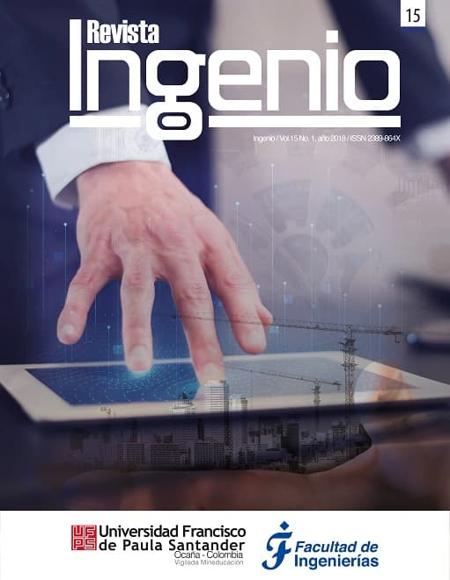Análisis de la productividad de mano de obra para la construcción de una vivienda unifamiliar en el municipio de Ocaña, Norte de Santander
Analysis of labor productivity for the construction of a single-family home in the municipality of Ocaña Norte de Santander
Contenido principal del artículo
La productividad se define matemáticamente como la cantidad producida de una actividad sobre el trabajo realizado en ella; se han avanzado en muchos estudios a nivel internacional y nacional donde se ha logrado la optimización en cuanto a productividad de mano de obra para las diferentes categorías de trabajo, una investigación realizada por el sistema de gestión de productividad de la Universidad Pontificia de Chile mostro que el Trabajo Productivo fue de (TP 60%), Trabajo Contributivo de (TC 25%) y Trabajo No Contributivo de (TNC 15%). Esta investigación contemplo el análisis de la productividad de mano de obra a una vivienda unifamiliar; identificándose las actividades de mayor impacto económico del proyecto a través de una herramienta de calidad, tomando muestras aleatorias para las actividades en estudio mediante la fórmula de población infinita y aplicando la técnica de los cinco minutos a cada actividad; se tabularon los datos empleando estadística descriptiva arrojando los siguientes resultados: El Trabajo Productivo fue de (TP 56%), Trabajo Contributivo de (TC 29%) y Trabajo No Contributivo de (TNC 15%). Algunas categorías de trabajo no estuvieron dentro de las óptimas esto se debió a las tareas contributivas las cuales no fueron optimizadas en el proceso constructivo.
Descargas
Datos de publicación
Perfil evaluadores/as N/D
Declaraciones de autoría
Indexado en
- Sociedad académica
- Universidad Francisco de Paula Santander
- Editorial
- Universidad Francisco de Paula Santander
Detalles del artículo
Gómez, J. M., & Bottini, M. Á. N. “Productividad de las empresas de la zona extractiva minera-energética y su incidencia en el desempeño financiero en Colombia.” Estudios gerenciales, vol.33(145), pp. 330-340, 2017. Doi:https://doi.org/10.1016/j.estger.2017.11.002 DOI: https://doi.org/10.1016/j.estger.2017.11.002
Serpell, A. “Productividad en la construcción”. Revista Ingeniería de Construcción, vol. 1(1), pp.53-59, 2011.
Botero Botero, L. F. “Análisis de rendimientos y consumos de mano de obra en actividades de construcción.” Revista Universidad EAFIT, vol.38(128), pp. 9-21. 2002.
Aguilar, G. M., & Hernández, T. C. “Seguimiento de la productividad en obra: técnicas de medición de rendimientos de mano de obra.” Revista UIS ingenierías, vol. 6(2), pp. 45-59, 2007.
Díaz, H. P., Rivera, O. G. S., & Guerra, J. A. G. “Filosofía Lean Construction para la gestión de proyectos de construcción. Avances: Investigacion en Ingeniería,” vol.11(1), pp. 32-53. 2014. DOI: https://doi.org/10.18041/1794-4953/avances.1.298
Contreras, C., Edwards, G., & Mizala, A. “La productividad científica de economía y administración en Chile: un análisis
comparativo.” Cuadernos de economía, vol. 43(128), pp. 331-354. 2006.
López, M. D. R., Grajales, M. H., &Corrales, M. E. V. “Lean construction–LC bajo pensamiento Lean”. Revista Ingenierías Universidad de Medellín, vol.16(30), pp.115-128, 2017. Doi: https://doi.org/10.22395/rium.v16n30a6 DOI: https://doi.org/10.22395/rium.v16n30a6
Howell, G. A. What is lean construction-1999. In Proceedings IGLC, vol. 7, p. 1,July, 1999.
Mínguez, J. B. P., & Moreno, A. S. (2004). Calidad del diseño en la construcción. Ediciones Díaz de Santos.
Carro, R., & González Gómez, D. A. (2012). Productividad y competitividad.
Borjas, C. M. B. “Ley de pareto aplicada a la fiabilidad”. Ingeniería mecánica, vol.8(3), pp.1-9, 2005.
Vargas Biesuz, B. E. “Tópicos de inferencia estadística: El método inductivo y el problema del tamaño de la muestra. Fides et Ratio”, Revista de Difusión cultural y científica de la Universidad La Salle en Bolivia, vol.7(7),pp. 86-92, 2014.









